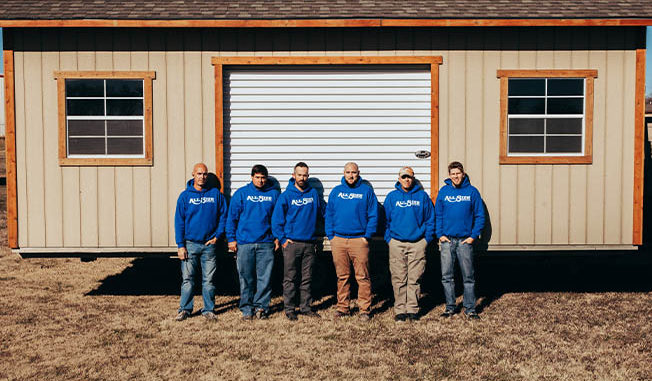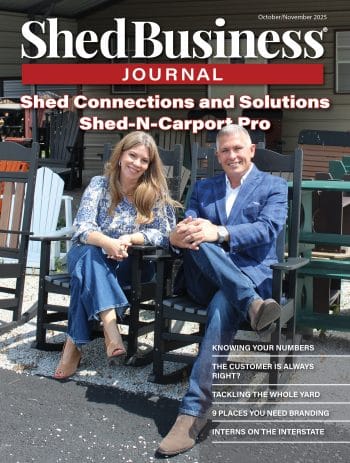
A single question led to the creation of All Size Shed Co.
“Think you can build me a shed?”
After being asked enough, founder Carl Brown, who was building fences at the time, built some sheds.
In time, Brown realized that shed building was more stable than fence building, and he made the switch from fences to sheds.
One aspect of fence building has remained a part of All Size Shed Co.—on-site construction.
Shed Builder Magazine spent some time with company president Jordan Crane to learn about how All Size Shed Co. runs its business as a mostly on-site builder.
Tell the readers about how All Size Shed Co. and its eventual move into portable structures.
My father-in-law, Carl Brown, started out building fences in 1974 in Sand Springs, Oklahoma. After continued requests, he started building a few storage sheds for customers.
Demand continued to grow, and he realized it was a much more standalone sale with fewer surprises than fence work. Eventually, we got out of the fence business altogether in the late ’80s and moved to Wichita, Kansas. Carl retired in 2018.
What types of structures do you offer today?
We have built storage sheds, gazebos, playhouses, ramadas, pergolas, carports, swing sets, and even sold a few trampolines.
Your marketing highlights a local focus. What is your local market? What are the popular structure demands in the area? Do you find that local focus results in loyalty?
The Wichita market seems to mainly be for mid-sized storage buildings 12 by 12 to 12 by 16.
We seem to notice more and more of our signs on neighboring sheds while we are on site. Word-of-mouth is our best advertising.
What does your operation look like these days?
We generally sell around 400-500 units a year, but 2020 looks to be near 700.
We have three office/yard/transport guys and four builders. We generally build 90 percent on-site in the customer’s backyard. We move more buildings for hire than we do delivering our own fully assembled sheds.
We offer Hardie and LP SmartSide, lap and panels. We have done some all-metal buildings, but there seems to not be as much demand with homeowner association (HOA) requirements locally.
What made you decide to go mostly on-site for building the structures you offer?
We have always tried to keep costs as low as possible, and for us, that means having a smaller yard, no giant indoor assembly area, and less overhead. There are fewer hands that have to touch a building or its materials for an on-site assembly.
Our community seems to place homes so close together it would be difficult to deliver a building of much size whole.
What challenges do building mostly on-site present, and how do you overcome them?
Generally, we have less assembled inventory, so customers often have to wait until their turn in line comes up. Most seem to not have any issue with this, however, and we try to keep a few buildings on hand for rush jobs with good access.
On-site assembly actually helps in some regards. Since nothing is precut or laid out, we can always move doors or windows around if the shed’s position in the yard needs to shift to fit the grade or clear trees, etc.
Our materials are sorted in our yard in the order in which the package is gathered and loaded. We have a load list for each size and style that tells us how many of each item to collect.
Our employees have to be able to do it all, from sales to running a forklift. There is always something to do and a team effort is required. No one is above any particular role, even though we each may have a main focus.
For the on-site builds, do you size and cut on-site, or do you handle most of that when you put the materials together in the yard before heading to the site?
Our on-site builds are almost completely uncut. This gives us a bit of leeway to pick and choose the best of the lumber for the most critical/visible locations.
You mentioned HOAs earlier. Do your customers ever have any issues with them after you build a shed? What steps do you take to help keep in HOA guidelines?
HOAs seem to vary from one to the next quite a bit, but most are not unreasonable. You just have to play their game.
How long does it take from first contact to building a shed? How long does it take for your team to build a shed?
Some sales are three-plus months in the making, from initial contact to completion. The majority of builds take one builder one day.
How much customization can a buyer make to a shed? What are some of the more popular features requested?
The sky is the limit. We jokingly say we will build anything you want to pay for. Many customers have found a style or feature on Pinterest or from one of our competitors they like and ask if we can help.
Custom doors and windows are common. Larger porch/overhang areas are getting popular, as well.
What have been some of your overall challenges as a shed builder, and how have you overcome them?
The supply chain has been the greatest limitation this year. Luckily the majority of customers have been very understanding.
Scheduling is always an issue, as weather can cause grief in Kansas, but we keep our hard schedule only a few days out. Texting has helped us to keep in better contact with customers as well, since no one answers unknown phone calls anymore.
How has COVID-19 affected your business?
It seems like everyone skipped summer vacation and instead decided to spend the money on home improvement projects. There was a brief period we weren’t sure if we would ever sell another building, but since then it has been nonstop, record-breaking sales.
What does the future look like for All Size Shed Co.?
We are very content with what we have. We would like to continue to expand into more customization, but we don’t seek to expand into multi-state domination anytime soon.
Local matters most, and we all have families we want to spend time with in the evenings.




